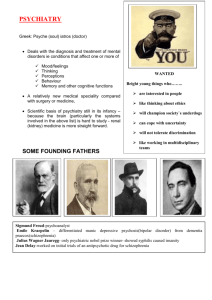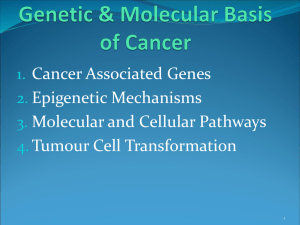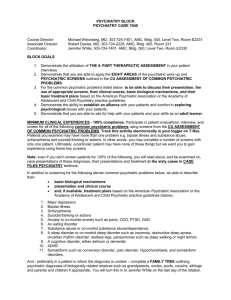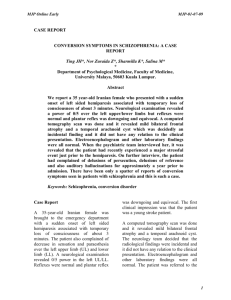Chapter 25 - Universiteit van Stellenbosch
advertisement
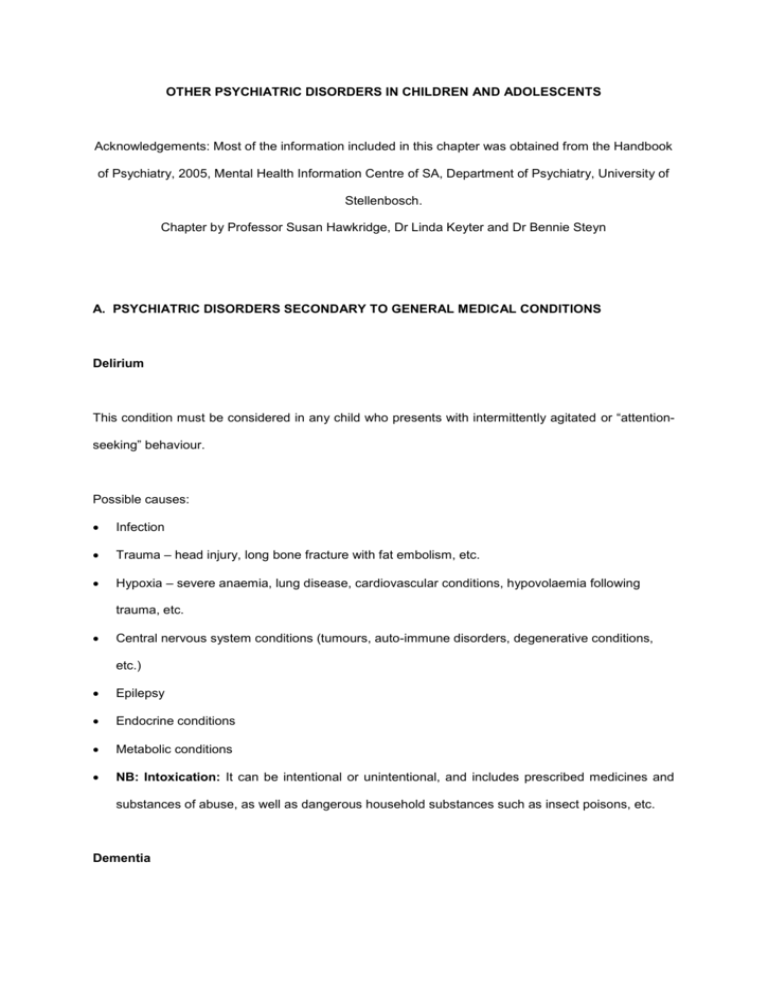
OTHER PSYCHIATRIC DISORDERS IN CHILDREN AND ADOLESCENTS Acknowledgements: Most of the information included in this chapter was obtained from the Handbook of Psychiatry, 2005, Mental Health Information Centre of SA, Department of Psychiatry, University of Stellenbosch. Chapter by Professor Susan Hawkridge, Dr Linda Keyter and Dr Bennie Steyn A. PSYCHIATRIC DISORDERS SECONDARY TO GENERAL MEDICAL CONDITIONS Delirium This condition must be considered in any child who presents with intermittently agitated or “attentionseeking” behaviour. Possible causes: Infection Trauma – head injury, long bone fracture with fat embolism, etc. Hypoxia – severe anaemia, lung disease, cardiovascular conditions, hypovolaemia following trauma, etc. Central nervous system conditions (tumours, auto-immune disorders, degenerative conditions, etc.) Epilepsy Endocrine conditions Metabolic conditions NB: Intoxication: It can be intentional or unintentional, and includes prescribed medicines and substances of abuse, as well as dangerous household substances such as insect poisons, etc. Dementia Cognitive deficits that appear before the age of 18 years are diagnosed according to the DSM-IV as mental retardation. In young people whose early development has proceeded normally and stabilised, the diagnosis of dementia can also be made when a general medical condition has caused a clear and permanent deterioration in cognitive functioning. Examples of causes: Recurrent substance abuse over long periods Central nervous system infection: haemophilus or tuberculous meningitis, brain abscess, HIV, etc. Metabolic: uraemia, untreated or repeated hypoglycaemia, etc. Trauma: head injury, etc. Hypoxia: drowning, etc. Endocrine: hypothyroidism, etc. Degenerative neurological conditions: Huntington's, Wilson's, etc. Central nervous system tumours Iatrogenic: chemotherapy for diseases such as leukaemia, brain surgery, etc. Psychosis Degenerative disorders such as Huntington’s disease and Wilson’s disease, brain tumours, encephalitis (especially neurosyphilis or subacute sclerosing panencephalitis), autoimmune disorders such as systemic lupus eythematosis, endocrine abnormalities such as thyroid abnormalities, metabolic disorders such as porphyria, drugs such as steroids, vitamin B 12 deficiency and toxic substances such as thallium are all possible causes of a psychotic picture. The clinical features may imitate those of schizophrenia or those of mania. Depression Many general medical conditions can cause depression. Examples are brain tumours and cysts, head injuries, cerebral SLE, hypothyroidism, porphyria and thiamine deficiency. Several drugs can also cause depression. See also adult psychiatry notes for further discussion of psychiatric disorders secondary to general medical conditions. Remember that children and adolescents are also subject to most of the same general medical conditions. Epilepsy A condition that commonly occurs in younger patients and warrants specific attention is epilepsy. Psychiatric symptoms in children with epilepsy can be part of the disorder, complications of treatment or secondary to the disorder. B. EARLY ONSET SCHIZOPHRENIA AND BIPOLAR DISORDER In prepubertal children it can sometimes be difficult to establish the difference between delusions/hallucinations and fantasy. Young children who are distressed by their fantasies and those who appear to be psychotic should be evaluated by a child psychiatrist. In older children, the expression of delusions, hallucinations and thought disorder becomes clearer, and there is usually an associated deterioration in functioning or the child does not reach his/her expected levels of social and academic functioning. Such children must also preferably be referred to a specialist unit. Schizophrenia Although the first episode of schizophrenia usually occurs in young adults, there is a significant number of adolescents in our community with so-called “early onset schizophrenia”. (Children under 12 years can also develop schizophrenia, so-called “very early onset schizophrenia”, but it is very rare.) Thus the general practitioner must be aware of the possibility of this disorder in young patients. Bipolar disorder This condition occurs most commonly in young adults, but is increasingly being sought and diagnosed in adolescents. The presentation of bipolar disorder in children under the age of 12 years is rare, but still possible. The first episode in girls often presents as depression, and in boys, mania, but local experience is that it is the manic phase in both girls and boys that first brings the child to hospital. The depressive episode, if present, is probably being missed by the family and the school. Bipolar disorder type II and cyclothymia also occur in younger patients, but diagnosis can be difficult. If these conditions are suspected in younger patients, the child should preferably be referred for specialist evaluation. C. SOMATOFORM, FACTITIOUS AND DISSOCIATIVE DISORDERS (See adult psychiatry notes for definitions, general principles, etc.) Of particular importance when the patient is a child or adolescent, are the following points: Children, particularly those with cognitive delays, are more inclined to express their emotional problems as physical symptoms. These symptoms are not always intentionally produced – insight is normally dependent on developmental and intelligence level. Severe stressors or “unacceptable” feelings can cause the child to develop unconsciously physical symptoms that give expression to the underlying conflict (conversion disorder). Becoming angry with such children is counterproductive. Dissociative disorders can be caused by severe stressors. A child who has been traumatised and then cannot give a complete account of the incident is not necessarily untrustworthy! D. GENDER IDENTITY DISORDER IN CHILDREN (see also adult psychiatry notes) By “gender identity” we mean the individual’s subjective knowledge of and satisfaction with the gender to which s/he physically belongs. From 3 years old, most children will know whether they are boys or girls, and will be content in this knowledge. They will identify with other children of the same gender and also with the parent of that gender. “Gender role” is an expression that is used for the behaviour that is culturally typical for that gender and how a child shows his gender identity through clothing and play. From the age of 5 years the average child will choose to play with children of the same gender, and this holds until puberty, when the child begins to develop sexually. “Sexual orientation” concerns choices of sexual partner, and has nothing to do with gender identity. Homosexual orientation may be established early, and is not viewed as a psychiatric disorder. However, any adolescent who is disturbed by the direction of his/her sexual inclinations should receive counselling and support, and the matter should be very sensitively handled. References 1. Trzepacz PT. Delirium. Advances in diagnosis, pathophysiology, and treatment. Psychiatr Clin North Am 1996:19(3):429-48. 2. Ravenscroft A. Anticonvulsant therapy in childhood - new and old. Specialist Medicine 2000; 12(4):208-13. 3. Emsley RA, Oosthuizen PP, Joubert AF, Roberts MC, Stein DJ. Depressive and anxiety symptoms in patients with schizophrenia and schizophreniform disorder. J Clin Psychiatry 1999;60(11):747-51. 4. Lewinsohn P, Klein D, Seeley J. Bipolar disorders in a community sample of older adolescents: prevalence, phenomenology, comorbidity and course. J Am Acad Child Adolesc Psychiatry 1995;34:454-63. 5. Kashani J, McNaul J. Mood Disorders in Adolescents. In: Wiener J, ed. Textbook of Child and Adolescent Psychiatry (2nd Edition). Washington DC: American Psychiatric Press, 1997:343-85. 6. Meadow R. What is, and what is not, 'Munchausen syndrome by proxy'? [see comments]. Arch Dis Child 1995;72(6):534-8. 7. Bakker A, van Kesteren P, Gooren L, et al. The prevalence of transsexualism in the Netherlands. Acta Psychiatr Scand 1993;87:237-8. 8. Green R. The “Sissy Boy Syndrome” and the Development of Homosexuality. New Haven, CT: Yale University Press, 1987.


